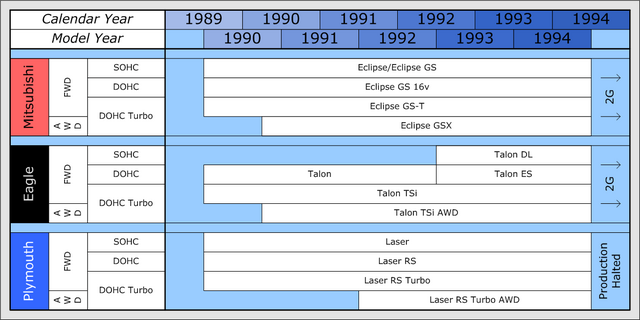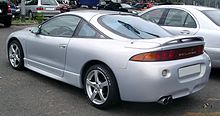
The Honda Integra, sold in North America as the Acura Integra and later the Acura RSX, is an automobile produced by the Japanese company Honda from 1985 until 2006, and then since 2021. It succeeded the Quint as a more luxurious and sport-oriented derivative of the Civic. The Integra was one of the launch models for Acura in the US in 1986 alongside the Acura Legend. Throughout its production run, the Integra was highly regarded for its handling and performance. The 1995–2001 Integra Type R is widely regarded as one of the best front-wheel-drive cars of all time.

The Ford Laser is a compact car, originally a subcompact car in the first three generations, which was sold by Ford in Asia, Oceania, and parts of South America and Africa. It has generally been available as a sedan or hatchback, although convertible, wagon and pick-up versions have also been available in different markets. The sedan, and briefly station wagon, versions were badged Ford Meteor in Australia between 1981 and 1987. The Ford Meteor name was also used in South Africa.
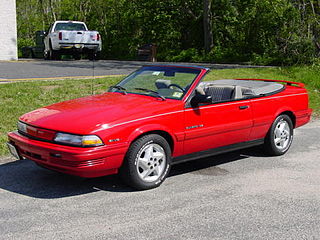
The Pontiac Sunbird is a model line that was manufactured and marketed by Pontiac from the 1976 to the 1994 model years. Loosely deriving its name from the Pontiac Firebird, the Sunbird was introduced as the eventual replacement for the Pontiac Astre, replacing it entirely in 1978 as the smallest Pontiac.
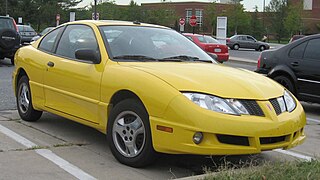
The Pontiac Sunfire is a compact car by Pontiac that was introduced for the 1995 model year to replace the Sunbird. Not only was the name changed, but dramatic styling changes were included as well. The new styling was shared with the redesigned Chevrolet Cavalier. The J platform was updated structurally to meet more stringent safety standards for the 1996 model year.

The Eagle Talon is a sport compact hatchback coupé manufactured as part of a joint venture between Chrysler and Mitsubishi in two generations starting from the 1989 model year.

The Mitsubishi 3000GT is a front-engine, all-wheel/front-wheel drive grand touring/sports car manufactured and marketed by Mitsubishi from 1990 until 2000 over three different generations. Manufactured in a three-door hatchback coupé body style in Nagoya, Japan, the 2+2 four-seaters were marketed in the Japanese domestic market (JDM) as the GTO, and globally as 3000GT. In North America, it was sold both as the Mitsubishi 3000GT (1991–1999) and the Dodge Stealth (1991–1996), a badge engineered, mechanically identical captive import. As a collaborative effort between Chrysler and Mitsubishi Motors, Chrysler was responsible for the Stealth's exterior styling.

The Mazda MX-6 is a front-engine, front-wheel-drive coupé manufactured and marketed by Mazda from 1987 to 1997 across two generations.
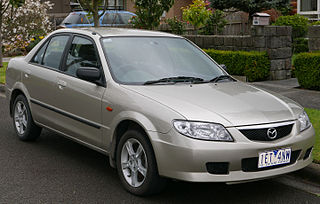
The Mazda Familia, also marketed prominently as the Mazda 323, Mazda Protegé and Mazda Allegro, is a small family car that was manufactured by Mazda between 1963 and 2003. The Familia line was replaced by the Mazda3/Axela for 2004.

The Plymouth Laser is a two-door 2+2 sports coupe sold by Plymouth from 1989 until 1994. The Laser and its siblings, the Mitsubishi Eclipse and Eagle Talon, were the first vehicles produced under the newly formed Diamond-Star Motors, a joint-venture between the Chrysler Corporation and the Mitsubishi Motors Corporation.
The JA platform was Chrysler's smaller complement to the LH cars which were larger than the Ks, and a direct size replacement for the last extended K cars, the Acclaim and Spirit. It was a mid-size front-wheel drive automobile platform that was the basis for the Cloud Cars — the Chrysler Cirrus/Dodge Stratus/Plymouth Breeze starting in 1994. Like the LH, it was a cab forward design. While this platform was numerically successful, the highest volume for family cars competing against cars like the Taurus, Accord, or Camry would move to the LH platform cars, which were often classified as full-size.

The Dodge Avenger is a front-wheel drive, mid-sized sedan that was marketed by Dodge. The Avenger made its North American debut in 1994 for the 1995 model year as a coupe that was produced until 2000. The model name was reintroduced to the market as a four-door sports sedan starting in 2007 for the 2008 model year. The Dodge Avenger name had earlier been used on South African market Hillman Avengers in 1975 and 1976.

The Renault 21 is a large family car produced by French automaker Renault between 1986 and 1994. It was also sold in North America initially through American Motors dealers as the Renault Medallion and later through Jeep-Eagle dealers as the Eagle Medallion. A total of 2,096,000 units were produced.

The Nissan Skyline is a brand of automobile originally produced by the Prince Motor Company starting in 1957, and then by Nissan after the two companies merged in 1967. After the merger, the Skyline and its larger counterpart, the Nissan Gloria, were sold in Japan at dealership sales channels called Nissan Prince Shop. Starting with the Third Generation C10, the chassis, suspension and some of the engines were shared with the longer wheelbase Nissan Laurel from 1968-2002, when the formerly Prince factory at Musashimurayama was closed, and the Skyline shared its platform with the Nissan 350Z.

The Mitsubishi Lancer is an automobile produced by the Japanese manufacturer Mitsubishi Motors since 1973.

The Mitsubishi Sirius or 4G6/4D6 engine is the name of one of Mitsubishi Motors' four series of inline-four automobile engines, along with Astron, Orion, and Saturn.

The Mitsubishi Chariot is an automobile manufactured and marketed by Mitsubishi from 1983 to 2003. It is a small multi-purpose vehicle (MPV). Based on the SSW concept car first exhibited at the 23rd Tokyo Motor Show in 1979, the MPV derives its nameplate from chariots used by the ancient Greek and Roman empires.

The Corolla E90, introduced in 1987 for the 1988 model year, was the sixth generation of cars sold by Toyota under the Corolla nameplate. It was the last generation of Corolla to be classified as a subcompact car and the first to be exclusively front-wheel drive or all-wheel drive; the performance option of rear-wheel drive was dropped.

The Toyota Corolla E80 is a range of small automobiles manufactured and marketed by Toyota from 1983 to 1987 as the fifth generation of cars under the Corolla and Toyota Sprinter nameplates, with production totaling approximately 3.3 million, and most models adopting a front-wheel drive layout.

The fourth-generation Honda Civic is a Japanese sub-compact automobile. It was produced by Honda from 1987 until 1991 with the wagon continuing in production in some markets until 1996. The suspension had a new double-wishbone suspension in the front and an independent suspension in the rear, the wheelbase was increased to 250 centimetres (98 in) from that of the third-generation Civic, and the body was redesigned with a lower hood line and more glass, resulting in less drag. The redesigned Civic was introduced in 1987 for the 1988 model year. The fourth-generation Civic would be available in three variants; 3-door hatchback, 4-door sedan and 5-door wagon with various trim levels offered in each variant.

Subaru launched the third generation Japanese and world-market Legacy in June 1998, while the North American model was introduced in May 1999 for the 2000 model year. In all markets except for the United States, production lasted through 2002, with a limited production Blitzen model sold mid-cycle under the 2003 model year in Japan. Production in the United States lasted through 2004.




